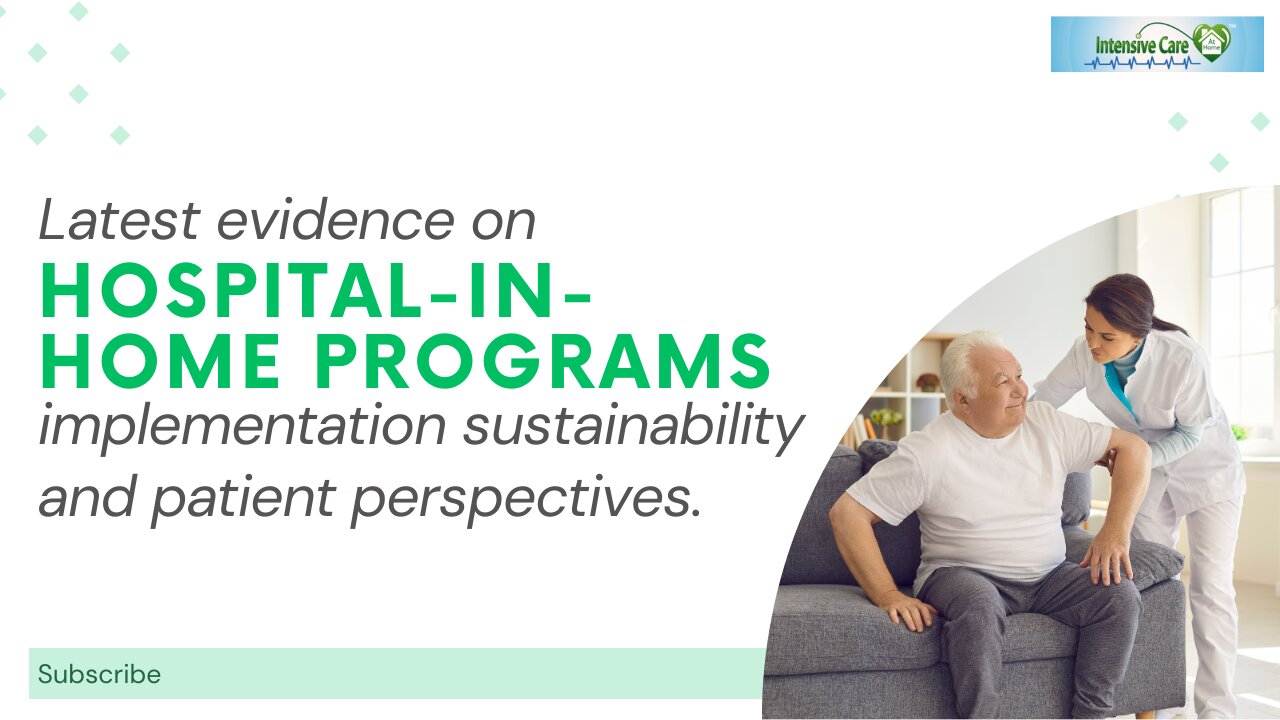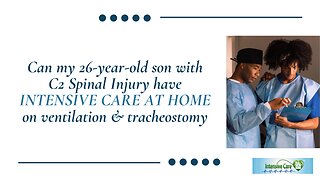Premium Only Content

Latest Evidence on Hospital-In-Home Programs Implementation Sustainability and Patient Perspectives
Latest Evidence on Hospital-In-Home Programs Implementation Sustainability and Patient Perspectives
Latest evidence on Hospital in the home programs: implementation, sustainability and patient perspectives — Cochrane Australia
https://www.cochraneaustralia.org/articles/latest-evidence-on-hospital-in-the-home-programs-implementation-sustainability-and-patient-perspectives
Book your free 15-minute phone consultation here
http://intensivecarehotline.com/scheduling-appointment/
Call directly 24/7
+1 415-915-0090 USA/Canada
+44 118 324 3018 UK
+6141 094 2230 Australia
Email support@intensivecarehotline.com
Get 1:1 consulting and advocacy
1:1 phone counselling
http://intensivecarehotline.com/one-on-one-counselling/
Become a member for families of critically ill Patients in Intensive Care
https://intensivecarehotline.com/intensivecaresupport-org-membership/
Immediate action steps http://intensivecarehotline.com/take-control-take-charge/immediate-action-steps/
https://intensivecareathome.com
And if you need a medical record review, click on the link and we can help you with reviewing your loved one’s medical records while they’re in ICU.
https://intensivecarehotline.thrivecart.com/review-of-medical-records/
Facebook Page: https://www.facebook.com/ICUhotline
Twitter: https://twitter.com/icuhotline
Song: Jarico - Island Music
supported by@FreeBackgroundMusicForCreators
#BackgroundMusicWithoutLimitations
https://bit.ly/2XoXFnb
#icu
#intensivecareunit
#criticalcare
It’s Patrik Hutzel from intensivecareathome.com where we provide tailor-made solutions for long-term ventilated adults and children with tracheostomies and where we also provide tailor-made solutions for hospitals and intensive care units, whilst providing quality services for long-term ventilated adults and children with tracheostomies. Also, otherwise medically complex adults and children at home, including home BIPAP (bilevel positive airway pressure), home CPAP (continuous positive airway pressure), home tracheostomy care when adults and children are not ventilated, also Home TPN (total parenteral nutrition). We also provide IV potassium, IV magnesium infusions at home, as well as IV antibiotic infusions at home. We also provide port management, central line management, PICC (Peripherally Inserted Central Catheter) line management, Hickman’s line management as well as palliative care services at home, and that also includes ventilator weaning at home.
Now, today, I want to focus on an Australian study. In more detail, I want to focus on a study that talks about, “The latest evidence on hospital in the home programs: implementation, sustainability, and patient perspectives.”
So, I want to I’ll just read out the article and I will also link to the article so that you can see where the source of this article is coming from. So, let me read this out.
“Two companion Cochrane reviews and the new Cochrane Library editorial on Hospital at home programs were published this week. Here, Cochrane authors Dr. Jason Wallis and Professor Sasha Shepperd share their key findings.”
There’s a heading now in the picture, “Hospital in the home or also known as HITH programs have been on the rise in response to the COVID-19 Pandemic”.
“’Hospital at home or – Hospital in the home (HITH) as it’s better known here in Australia – is a service designed for people whose condition would normally need treatment in a hospital bed,’ explains Jason Wallis, researcher at Monash University’s School of Public Health. ‘Instead, with HITH, they typically receive visits from a doctor, nurse and allied health professionals at home instead – just as they would if they were in hospital.’
‘We know there’s been a significant increase in HITH programs around the globe as an alternative to hospital admission, with more services being set-up during the COVID-19 pandemic to relieve the pressure on hospital beds and increase capacity. There are two types of programs. The first is called ‘admission avoidance’ as patients are referred by emergency doctors or general practitioners for HITH, thereby avoiding admission to a hospital ward. The other type is called ‘early discharge’ and is designed to shorten the length of time patients need to stay in hospital.’
For us here at Intensive Care at Home, it’s probably the latter but we have certainly focused on admission avoidance as well because we are also sending our critical care nurses into people’s home to avoid emergency department presentations. So, we’re doing both here at Intensive Care at Home.
Continue reading at: https://intensivecareathome.com/latest-evidence-on-hospital-in-home-programs-implementation-sustainability-and-patient-perspectives/
-
 13:32
13:32
Intensive Care at Home
13 days agoCan My 26-Year-Old Son with C2 Spinal Injury have INTENSIVE CARE AT HOME on Ventilation&Tracheostomy
111 -
 49:35
49:35
Donald Trump Jr.
17 hours agoA New Golden Age: Countdown to Inauguration Day | TRIGGERED Ep.202
191K195 -
 1:14:34
1:14:34
Michael Franzese
15 hours agoWhat's Behind Biden's Shocking Death Row Pardons?
82.7K49 -
 9:49
9:49
Tundra Tactical
14 hours ago $25.32 earnedThe Best Tundra Clips from 2024 Part 1.
138K11 -
 1:05:19
1:05:19
Sarah Westall
14 hours agoDying to Be Thin: Ozempic & Obesity, Shedding Massive Weight Safely Using GLP-1 Receptors, Dr. Kazer
118K32 -
 54:38
54:38
LFA TV
1 day agoThe Resistance Is Gone | Trumpet Daily 12.26.24 7PM EST
80.3K12 -
 58:14
58:14
theDaily302
23 hours agoThe Daily 302- Tim Ballard
75.2K13 -
 13:22
13:22
Stephen Gardner
17 hours ago🔥You'll NEVER Believe what Trump wants NOW!!
123K348 -
 54:56
54:56
Digital Social Hour
1 day ago $13.32 earnedDOGE, Deep State, Drones & Charlie Kirk | Donald Trump Jr.
70.5K6 -
 DVR
DVR
The Trish Regan Show
18 hours agoTrump‘s FCC Targets Disney CEO Bob Iger Over ABC News Alleged Misconduct
73.8K44